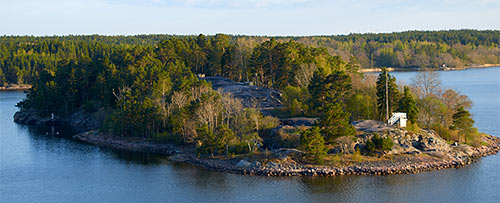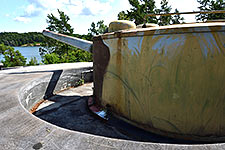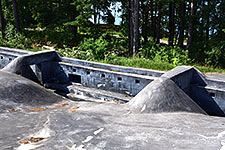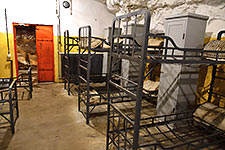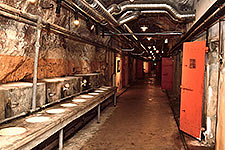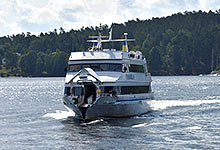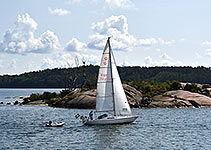Fort Siarö - Siaröfortet
Many have seen this wonderful fort from the board of the sea ferry, but few have been there. There is little information about Siarö fort, there are few links, and even those are all in the Swedish language... Let’s fill this gap in the worlwide fortification studies!
In the 16th century the mighty fortress of Vaxholm was erected to protect the approaches to Stockholm from the east. However, the development of artillery made this fortifications obsolete soon. To hit the enemy on distant approaches with well-aimed artillery fire - that was the new slogan of the day. The new principles of fortification said: 'to see everything, but to be invisible.' Therefore, in 1914 the Swedish Riksdag decided to build a new defense line in the Stockholm archipelago, consisting of minefields covered by coastal artillery fire.
In 1916, on the tiny islet of Kyrkogårdsö (Church Island) in the Furusundsleden Strait, on the sea channel leading to Stockholm, the construction of the fort of Siarö began, which was supposed to become the most perfect fortification in Sweden for that time. However, due to the complexity and novelty of the construction works, problems with financing and workers' strikes, the construction was delayed and the fort was finished only in 1926.
In the depths of the monolithic granite rocks, barracks for 270 people of the garrison, powder cellars, warehouses, a diesel generator, shelters for combat searchlights, a mine station, headquarters, and an artillery fire control post were cut down.
As the main caliber at the fort two 152-mm Bofors cannons in armored turrets were installed. They were taken from the coastal battleship named Svea. Two 57-mm quick-firing guns provided direct fire for the minefield in the strait. There were two powerful spotlights for the night battle at the fort. For anti-landing defense along the coast around the fort a continuous fence of barbed wire on metal stakes of 6-8 rows was made. It cold be covered by light and heavy small arms fire from concrete trenches. I would like to note that everything described is available on the fort at the present time and, in general, is available for inspection.
By 1939 a controversial opinion prevailed among the Swedish military that the fort Siarö was obsolete morally and techically and that the capital’s defense should be moved to the distant islands of the Stockholm archipelago. Therefore, the fort was withdrawn from the ranks, equipment and weapons were partially dismantled, however, the island remained under the jurisdiction of the military department as a training camp for coastal gunners until 1959. From 1959 to 1990 the fort was virtually abandoned to the will of the weather and the mercy of fate..
В 1991 году на форту начались восстановительные работы и в 2002 году он получил статус исторического памятника. В начале 2000-х гг Сиарё открылся для посетителей как музей. В настоящее время он является собственностью Департамента Национального Имущества (SVF - Statens fastighetsverk) и находится в управлении частной компании Blidösundsbolaget, которая также содержит небольшой хостел на острове, кафе, марины для яхт.
In 1991 a restoration works began at the fort and in 2002 it received the status of a historical monument. In the early 2000s, Siiaro was opened for visitors as a museum. It is currently owned by the Department of National Properties (SVF - Statens fastighetsverk) and is managed by the private company Blidösundsbolaget, which also holds a small hostel on the island, a cafe, and marinas for yachts.
Impressions
Impressions are very positive in all their aspects. It was interesting to sail to the fort by a leisurely ferry along the beautiful fjords of the Stockholm archipelago, past the mighty Vaxholm fortress. By the way, a trip to Fort Siarё can be easy combined with a visit to the Vaxholm citadel within one day.
The dungeons of the fort are vast and very damp, but no boots or lanterns are needed, there is electricity, railings are installed in dangerous places. Note to the traveler: the gun's turrets are usually closed, so it makes sense to make an inquire about the schedule of tours on the fort before a visit. And of course, before the trip, learn the Swedish language, otherwise you'll understand less than nothing on the tour. I allmänhet något liknande. Bon resa!
Land forts and fortress:
Bip Castle Gatchina Ivangorod Izborsk Kexholm Kirillov Monastery Koporye Novgorod Pechorskiy Monastery Peter&Paul Fortress Porkhov Pskov Schlisselburg Staraya Ladoga Tikhvin Vyborg Hameenlinna Hamina Kastelholm Kymenlinna Lappaenranta Raseborg Castle Savonlinna Tavetti Turku Visby Fredrikstadt Fredriksten Hegra Fort Hoytorp Fort Arensburg Narva Tallinn Antipatris Caesarea Jerusalem Latrun Fort Masada
Sea forts and fortresses:
Alexander Fort Ino Fort Krasnaya Gorka Fort Kronstadt: Kotlin isl. Kronstadt: North Forts Kronstadt: South Forts Trongsund Hanko Svartholm Sveaborg Marstrand Siaro Fort Vaxholm Oscarsborg
Artillery batteries and individual guns:
Coastal Artillery Hemso Fort
Fortified areas and defensive lines:
Karelian Fortified Area (KaUR) KrUR Leningrad Mannerheim Line Nevsky Bridgehead VT Line Harparskog Line Salpa Line Gothland
Russian
S e a r c h All news

